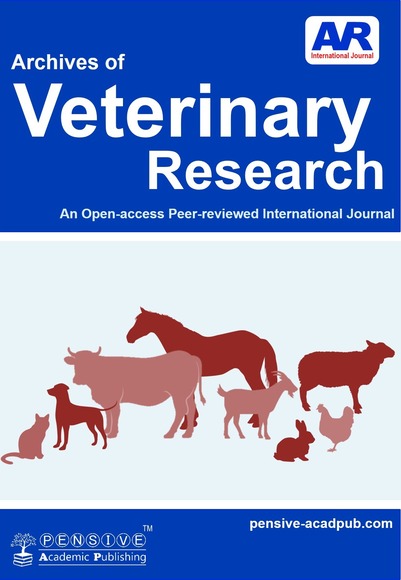Human adenovirus type 5 expressing FMDV serotype O (strain R2/75) capsid proteins and its immunogenicity in guinea pigs
Expression of FMD-VLPs in Adenoviral expression system and evaluating its immunogenicity
DOI:
https://doi.org/10.70964/avr.5Keywords:
Foot-and-mouth disease, FMD VLP vaccine, New generation vaccine, Guinea pigs, Electron Microscopy, Adenoviral expression system, Virus like ParticlesAbstract
Foot-and-mouth disease (FMD) is a highly contagious illness that significantly impacts cloven-hoofed animals and is of transboundary importance. The inactivated FMD vaccine is commonly used in countries like India to control the disease. Regular vaccination has helped to eradicate FMD in some countries and there are several concerns associated with the production and use of inactivated vaccines for FMD, which includes high costs associated with bio-containment facilities, potential risk of the virus escaping into the environment, and the vaccine's sensitivity to temperature changes. Therefore, the present study was aimed to develop a new generation FMD VLP vaccine using a Human adenovirus type-5 based expression system. In our study, the recombinant adeno-FMD virus showed efficient expression of the FMDV capsid proteins, which self-assembled into VLPs was observed by electron microscopy. The adeno-FMD vaccines protected fewer animals than conventional inactivated virus vaccines after homologous challenge. Recombinant adenovirus containing mutant 3Cpro was found superior to its wild-type counterpart in terms of protection. As no vaccine in the present study has given 100% protection, additional dose-response studies may provide information regarding the protective dose in guinea pigs. The data generated in the study suggest that the adeno-FMD vaccines may be an ideal alternative to the conventional inactivated virus vaccine.
References
1. Barteling, S. J. and Vreeswijk, J. 1991. Developments in foot-and-mouth disease vaccines. Vaccine. 9(2): 75-88. https://doi.org/10.1016/0264-410X(91)90261-4 PMid:1647575
2. Collen, T., Pullen, L. and Doel, T. R. 1989. T cell-dependent induction of antibody against foot-and-mouth disease virus in a mouse model. J. Gen. Virol. 70: 395-403. https://doi.org/10.1099/0022-1317-70-2-395 PMid:2543745
3. Doel, T. R. 2003. FMD vaccines. Virus Res. 91(1): 81-99. https://doi.org/10.1016/S0168-1702(02)00261-7 PMid:12527439
4. Du, Y., Dai, J., Li, Y., Li, C., Qi, J., Duan, S. and Jiang, P. 2008. Immune responses of recombinant adenovirus co-expressing VP1 of foot-and-mouth disease virus and porcine interferon alpha in mice and guinea pigs. Vet. Immunol. Immunopathol. 124: 274-283. https://doi.org/10.1016/j.vetimm.2008.04.011 PMid:18511133
5. Du, Y., Jiang, P., Li, Y., He, H., Jiang, W., Wang, X. and Honga, W. 2007. Immune responses of two recombinant adenoviruses expressing VP1 antigens of FMDV fused with porcine granulocyte macrophage colony-stimulating factor. Vaccine 25: 8209-8219. https://doi.org/10.1016/j.vaccine.2007.09.062 PMid:17980939
6. Grubman, M. J., and Baxt, B. 2004. Foot-and-mouth disease. Clin. Microbiol. Rev. 17: 465-493. https://doi.org/10.1128/CMR.17.2.465-493.2004 PMid:15084510 PMCid:PMC387408
7. Kumar, R., Sreenivasa, B. P. and Tamilselvan, R. P. 2015a. Construction and characterization of recombinant human adenovirus type 5 expressing foot-and-mouth disease virus capsid proteins of Indian vaccine strain, O/IND/R2/75. Veterinary World, 8(2): 147-155. https://doi.org/10.14202/vetworld.2015.147-155 PMid:27047064
8. Kumar, R., Basagoudanavar, S. H. and Sreenivasa, B. P. 2015b. Detection of replication competent adenovirus upon serial passaging of recombinant adenovirus expressing FMDV capsid proteins. Biologicals, 43: 209-212. https://doi.org/10.1016/j.biologicals.2015.02.002 PMid:25748638
9. Kushnir, N., Streatfield, S. and Yusibov, V. 2012. Virus-like particles as a highly efficient vaccine platform: Diversity of targets and production systems and advances in clinical development. Vaccine 31(1): 58-83. https://doi.org/10.1016/j.vaccine.2012.10.083 PMid:23142589 PMCid:PMC7115575
10. Lin, S. C., Huang, M. H., Tsou, P. C., Huang, L. M., Chong, P., Wu, S. C. 2011. Recombinant trimeric HA protein immunogenicity of H5N1 avian influenza viruses and their combined use with inactivated or adenovirus vaccines. PloS ONE 6: e20052. https://doi.org/10.1371/journal.pone.0020052 PMid:21655326 PMCid:PMC3104987
11. Lu, Z., Bao, H., Cao, Y., et al. 2008. Protection of guinea pigs and swine by a recombinant adenovirus expressing O serotype of foot-and-mouth disease virus whole capsid and 3C protease. Vaccine 26(Suppl 6): G48-53. https://doi.org/10.1016/j.vaccine.2008.09.066 PMid:19178894
12. Magalhaes, I., Sizemore, D. R., Ahmed, R. K., et al. 2008. rBCG induces strong antigen-specific T cell responses in rhesus macaques in a prime-boost setting with an adenovirus 35 tuberculosis vaccine vector. PloS ONE 3: e3790. https://doi.org/10.1371/journal.pone.0003790 PMid:19023426 PMCid:PMC2582491
13. Mayr, G. A., Chinsangaram, J. and Grubman, M. J. 1999. Development of replication-deficient adenovirus serotype 5 containing the capsid and 3C protease coding regions of foot-and-mouth disease virus as a vaccine candidate. Virol. 263(2): 496-506. https://doi.org/10.1006/viro.1999.9940 PMid:10544121
14. Plummer, E. M. and Manchester, M. 2011. Viral nanoparticles and virus-like particles: platforms for contemporary vaccine design. Wiley Interdiscip. Rev. Nanomed. Nanobiotechnol. 3(2): 174-196. https://doi.org/10.1002/wnan.119 PMid:20872839 PMCid:PMC7169818
15. Porta, C., Kotecha, A., Burman, A., Jackson, T., Ren, J., loureiro, S., Jones, I. M., Stuart, D. I. and Charleston, B. 2013a. Rational engineering of recombinant picornavirus capsids to produce safe, protective vaccine antigen. PloS Pathog. 9(3): e1003255. https://doi.org/10.1371/journal.ppat.1003255 PMid:23544011 PMCid:PMC3609824
16. Porta, C., Xu, X., Loureiro, S., et al. 2013b. Efficient production of foot-and-mouth disease virus empty capsids in insect cells following down regulation of 3C protease activity. J. Virol. Methods 187(2): 406-412. https://doi.org/10.1016/j.jviromet.2012.11.011 PMid:23174161 PMCid:PMC3558679
17. Richardson, J. S., Abou, M. C., Tran, K. N., Kumar, A., Sahai, B. M. and Kobinger, G. P. 2011. Impact of systemic or mucosal immunity to adenovirus on ad-based ebola virus vaccine efficacy in guinea pigs. J. Infect. Dis. 204: S1032-S1042. https://doi.org/10.1093/infdis/jir332 PMid:21987739
18. Rodriguez, A., Goudsmit, J., Companjen, A., et al. 2008. Impact of recombinant adenovirus serotype 35 priming versus boosting of a Plasmodium falciparum protein: characterization of T- and B-cell responses to liver-stage antigen 1. Infect. Immun. 76(4): 1709-1718. https://doi.org/10.1128/IAI.01614-07 PMid:18212075 PMCid:PMC2292849
19. Romanutti, C., Antuono, A., Palacios, C., Quattrocchi, V., Zamorano, P., La Torre, J. and Mattion, N. 2013 Evaluation of the immune response elicited by vaccination with viral vectors encoding FMDV capsid proteins and boosted with inactivated virus. Vet. Microbiol. 165(3-4): 333-340. https://doi.org/10.1016/j.vetmic.2013.04.017 PMid:23683999
20. Rueckert, R. R. 1996. Picornaviridae: The viruses and their replication. In: Fields Virology (B.N. Fields, D.M. Knipe and P.M. Howley, Eds.), 3rd ed., Vol.2. Lippincott-Raven, Philadelphia, Pa. pp. 609-654.
21. Rweyemamu, M. M., Terry, G. and Pay, T. W. 1979. Stability and immunogenicity of empty particles of foot-and-mouth disease virus. Arch. Virol. 59(1-2): 69-79. https://doi.org/10.1007/BF01317896 PMid:218538
22. Sanz-Parra, A., Jimenez-Clavero, M. A., Garcia-Briones, M. M., Blanco, E., Sobrino, F. and Ley, V. 1999. Recombinant viruses expressing the foot-and-mouth disease virus capsid precursor polypeptide (P1) induce cellular but not humoral antiviral immunity and partial protection in pigs. Virol. 259(1): 129-134. https://doi.org/10.1006/viro.1999.9717 PMid:10364496
23. Srinivas MV, Basagoudanavar SH, Hosamani M. IRES mediated expression of viral 3C protease for enhancing the yield of FMDV empty capsids using baculovirus system. Biologicals. 2016; 44: 64-68. https://doi.org/10.1016/j.biologicals.2015.12.002 PMid:26775685
24. Srinivas, M.V.; Basagoudanavar, S.H.; Tamil Selvan, R.P.; Hosamani, M. Modulating the level of expression of 3C protease in relation to capsid precursor (P1) of FMD virus enhances the yield of empty capsids. Int. J. Curr. Biotechnol. 2015, 3, 1-7.
25. Turner, P., Patch, A. and Al-Rubeai, M. 2007. Encapsulation of viral vectors for gene therapy applications. Biotechnol. Prog. 23(2): 423-429. https://doi.org/10.1021/bp0600177 PMid:17286384
26. Wang, D., Hevey, M., Juompan, L. Y., et al. 2006. Complex adenovirus-vectored vaccine protects guinea pigs from three strains of Marburg virus challenges. Virol. 353: 324-332. https://doi.org/10.1016/j.virol.2006.05.033 PMid:16820184
27. Wong, G., Richardson, J. S., Cutts, T., Qiu, X. and Kobinger, G. P. 2015. Intranasal immunization with an adenovirus vaccine protects guinea pigs from Ebola virus transmission by infected animals. Antiviral Res. https://doi.org/10.1016/j.antiviral.2015.01.001 PMid:25596432
28. Zhou, G., Wang, H., Wang, F. and Yu, L. 2013. Recombinant adenovirus expressing type Asia1 foot-and-mouth disease virus capsid proteins induces protective immunity against homologous virus challenge in mice. Res. Vet. Sci. 94(3):796-802. https://doi.org/10.1016/j.rvsc.2012.12.004 PMid:23267820
29. Zhou, Z., Mogensen, M. M., Powell, P. P., Curry, S. And Wileman, T. 2013. Foot-and-mouth disease virus 3C protease induces fragmentation of the Golgi compartment and blocks intra-Golgi transport. J. Virol. 87(21): 11721-11729. https://doi.org/10.1128/JVI.01355-13 PMid:23986596 PMCid:PMC3807340
Downloads
Published
How to Cite
Issue
Section
License
Copyright (c) 2024 © 2024 Pensive Academic Publishing. All rights reserved. | Archives of Veterinary Research

This work is licensed under a Creative Commons Attribution 4.0 International License.




